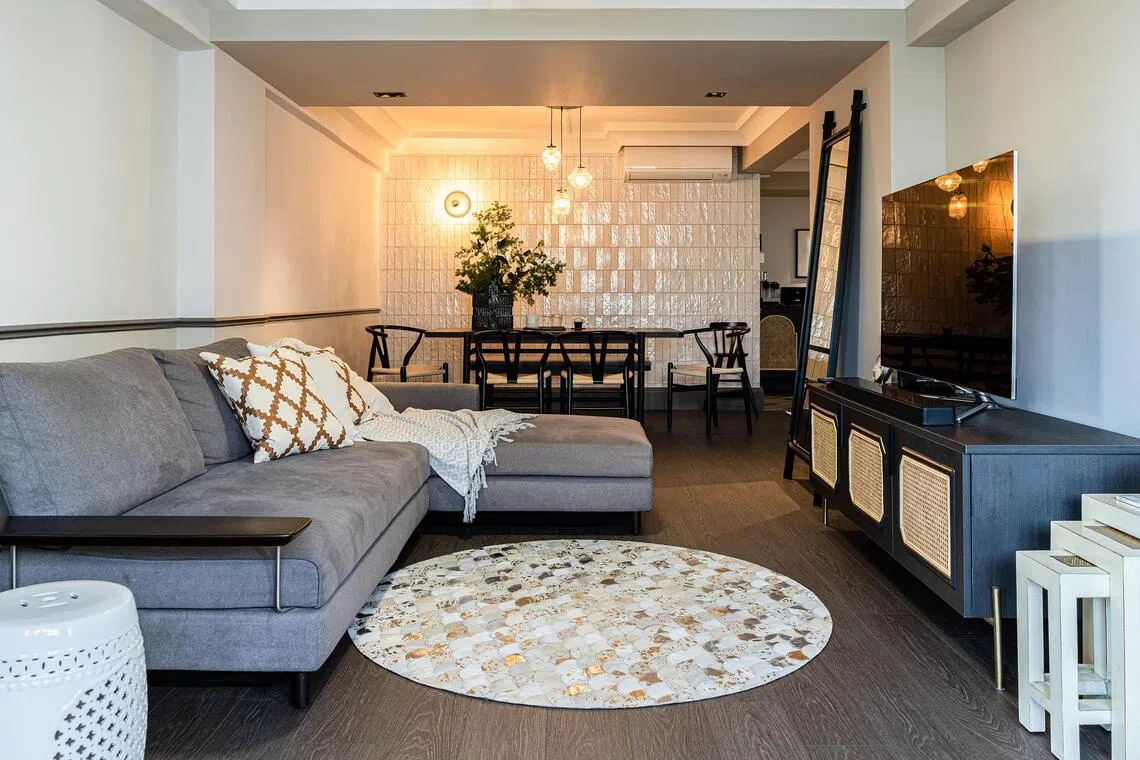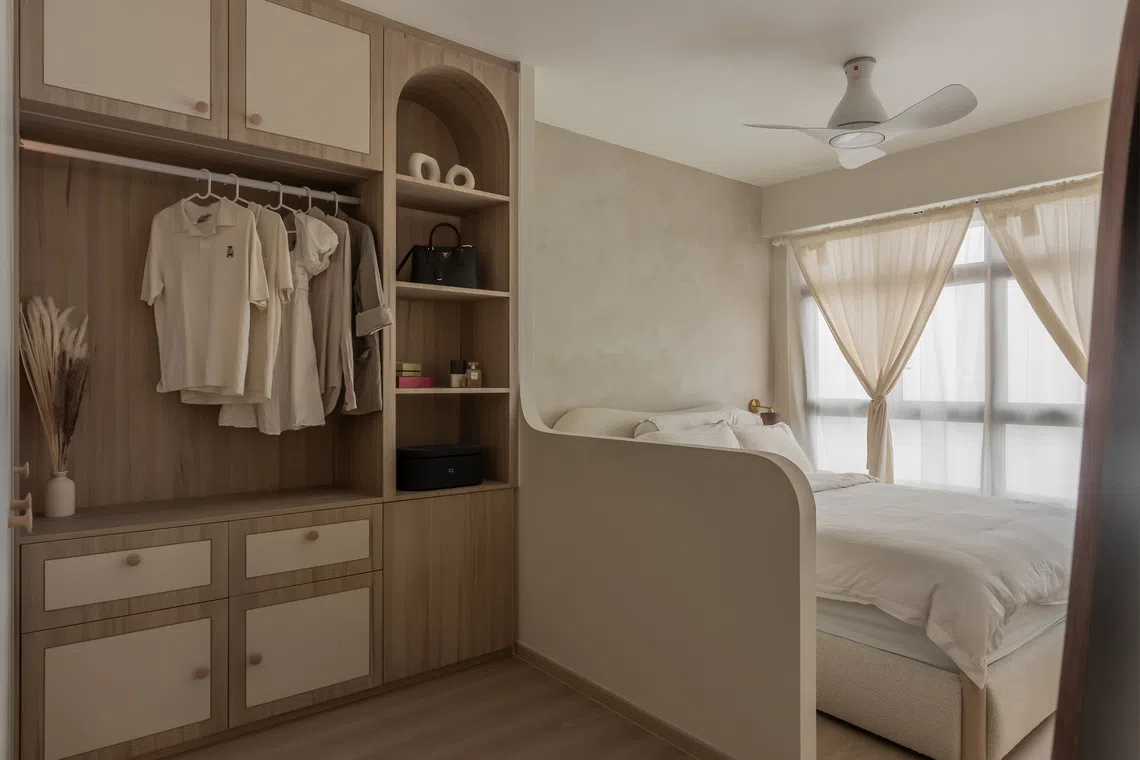What to know about designing a feature wall for your home
Sign up now: Get tips on how to grow your career and money

Wallpaper is one way to implement a feature wall in a room.
PHOTO: GLORIOUS STATE
Follow topic:
- Feature walls transform rooms by adding ambience, depth and personality using colour, texture or unique materials.
- Options range from affordable paint to pricier built-in cabinetry.
- While trendy, a feature wall may not suit every space; alternatives include unique lighting or rugs, and DIY limewashing requires specific techniques and primers.
AI generated
SINGAPORE – Arguably, a wall is just a wall: one of the many elements that make up an overall living space.
But when done up just right – such as with a splash of colourful paint, vibrant wallpaper or bespoke carpentry – it can transform a room from a functional space into a focal point of the home.
For people looking to refresh or decorate a single room, focusing on one wall – rather than revamping the entire space from flooring to furniture – can make all the difference.
As Ms Amilia Gani, principal designer at interior design firm Facelift Design & Interiors, explains: “A well-designed feature wall transforms a room with ambience, adds depth between spaces and makes the room a unique and memorable part of the home.”
The idea, she adds, is to treat it differently from other walls – for instance, through the use of colour and texture – to create a focal point. This, in turn, will give the room a sense of personality and visual interest.
A common approach to feature walls in Singapore is to use built-in cabinetry to design a TV console area that also doubles as a storage or display cabinet.
Ms Berinda Soh, founder and principal designer at design firm Glorious State, adds: “It is recommended to place the feature wall behind key furniture items, such as a sofa or bed, to act as a backdrop or focal point.
“My own preference is for the feature wall to be visible when one enters the room because that will also make the room more welcoming.”
A feature wall can come in different formats, from painted walls and wallpaper to fluted panels and built-in cabinetry. These can be mixed and matched. More unusual options include floor tiles, an art installation – for instance, a mural – or a full piece of natural stone such as marble.

A feature wall in a dining room that uses tiles to create an accent texture.
PHOTO: AMILIA GANI
Prices vary for these options, but paint is generally the most affordable, partly because it is also the easiest one to do by yourself. A one-litre tub of Raffles Paint’s R.One, which is a combined paint and primer product, costs $35 and will likely cover 10 sq m with a single coat.
But paint does not necessarily have to be a low-rent option, even if it is the more economical one.
Ms Soh says: “Limewash is quite popular in Singapore. This is non-toxic paint made from lime putty – crushed limestone mixed with water – and it creates a soft, matt and textured finish on walls.”
There is also colour washing, which is a painting technique that creates a translucent, watercolour-like finish.
A feature wall does not necessarily have to be a wall, says Ms Amilia. “It could even be a fretwork partition between the living and dining spaces, or a set of statement curtains with bold patterned fabric. Both options would bring colour and/or texture into the room.”
There is also the option of creating a feature ceiling through the use of beams, panelling and cornices. “We sometimes call that the fifth wall. It can be used to complement the look and feel of the rest of the room or for visual impact, to draw attention to the height of the space in the room,” says Ms Soh.
Ultimately, both designers say, home owners should create a feature wall, ceiling or area that reflects their needs and aesthetic preferences.
“Carpentry with storage is very functional for families with children and for homes that lack space. Of course, the disadvantage is that you can’t change it any time – it tends to be a permanent fixture that requires some cost effort to dismantle,” says Ms Soh.
Ms Amilia advises her clients to not be fixated on the idea of a feature wall, especially if they are merely implementing it because it is trendy.
“Sometimes, a feature wall is just not going to work in a space. In such cases, there are many other design ideas that home owners can adopt,” she notes, suggesting a unique light fixture, a custom rug or ceiling design as alternatives.
“These touches will anchor the room, and can be more personal and interesting than an elaborate feature wall.”
DIY limewashing your feature wall – yay or nay?
Limewash has become a trendy option in Singapore in recent years, in lieu of traditional mineral paints. If done right, it can add a soft and cosy feel to a space.
It is crucial to understand the chemical difference between limewash – which is made of natural lime and water – and mineral paint, which is usually made of acrylic-based resins, as they behave differently.
This matters if you are planning to try limewashing your walls.
“Limewash etches itself into the wall,” says Mr Paul Li, co-founder of local firm Raffles Paint, which sells limewash paint in a variety of colours.
But this wall must be prepared with the appropriate primer, he adds.
For the best effect, limewash should also be applied with a special limewashing brush. This means it can take longer than regular painting, for which one can use time-saving equipment such as rollers.

Limewash can add a soft, cosy atmosphere to a room.
PHOTO: CHANNELINGCHANEL_/INSTAGRAM
If opting for the do-it-yourself route, the correct technique is also crucial or you risk leaving white patches on the wall.
But, done properly, limewash is a more eco-friendly and “healthier” option than mineral paint, which is made from artificial chemicals.
“Limewash contains little to no volatile organic compounds, so it does not have a strong smell when it is being applied and can even deter insects,” says Mr Li.


